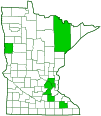strawberry tomato
(Physalis grisea)
Conservation • Wetland • Description • Habitat • Ecology • Use • Distribution • Taxonomy
Conservation Status |
|
|||||||
| IUCN Red List | not listed |
|||||||
| NatureServe | N5? - Secure |
|||||||
| Minnesota | not listed |
|||||||
Wetland Indicator Status |
||||||||
| Great Plains | FACU - Facultative upland |
|||||||
| Midwest | UPL - Obligate Upland |
|||||||
| Northcentral & Northeast | UPL - Obligate upland |
|||||||
Description |
||
Strawberry tomato is a 8″ to 12″ tall, erect, annual forb. The stems are widely branched from near the base. The upper part of the stem is densely covered with both long, soft, shaggy hairs and sticky, glandular hairs. The leaves are alternate, thin, stalked, egg-shaped, and 1⅛″ to 2″ long. They are broad and rounded or heart-shaped at the base, and taper to a point at the tip with straight sides along the tip. The margins have a 3 to 4 irregular teeth on each side or are untoothed. The upper and lower surfaces have silky, appressed hairs as well as glandular hairs. The upper surface is green, the lower surface pale green or whitish. When dry they are somewhat translucent. The inflorescence is single flowers nodding at the end of 3 ⁄16″ to ⅜″ long, glandular-hairy stalks (pedicels) rising from the leaf axils. The flowers are ¼″ to ⅜″ long and wide. There are 5 pale yellow petals with purple to brown splotches near the center. They are fused into a bell-shaped corolla with 5 shallow lobes. The fruit is a spherical, berry, green at first, turning yellowish-green at maturity. It is enclosed in an inflated, papery, heart-shaped, 5-angled, ¾″ long husk. The tip of the husk is mostly closed, and the base has a shallow indentation where it connects to the stem. The husk hangs from a pedicel that has elongated to ¾″. The berries are poisonous when green, edible when ripe. |
||
Height |
||
8″ to 12″ |
||
Flower Color |
||
Pale yellow with purple to brown centers |
||
Similar Species |
||
Habitat |
||
Moist. Waste places, fields. |
||
Ecology |
||
Flowering |
||
May to September |
||
Pests and Diseases |
||
|
||
Use |
||
|
||
Distribution |
||||
|
Sources |
|||
| 6/26/2023 | ||||
Nativity |
||||
Native to eastern North America. Introduced |
||||
Occurrence |
||||
Uncommon in Minnesota |
||||
Taxonomy |
|||
| Kingdom | Plantae (Plants) | ||
| Division | Tracheophyta (Vascular Plants) | ||
| Subdivision | Spermatophytina (Seed Plants) | ||
| Class | Magnoliopsida (Dicots) | ||
Order |
Solanales (nightshades, bindweeds, gooseweeds, and allies) | ||
Family |
Solanaceae (nightshade) | ||
| Subfamily | Solanoideae (nightshades and allies) | ||
| Tribe | Physaleae (groundcherries, lanterns, and allies) | ||
| Subtribe | Physalinae | ||
Genus |
Physalis (groundcherry) | ||
Subordinate Taxa |
|||
|
|||
Synonyms |
|||
Physalis pruinosa Physalis pubescens var. grisea Physalis pubescens var. integrifolia |
|||
Common Names |
|||
downy ground-cherry dwarf cape-gooseberry hairy ground cherry hairy ground-cherry husk tomato strawberry ground-cherry strawberry tomato |
|||
Glossary
Corolla
A collective name for all of the petals of a flower.
Glandular hairs
Hairs spread over aerial vegetation that secrete essential oils. The oils act to protect against herbivores and pathogens or, when on a flower part, attract pollinators. The hairs have a sticky or oily feel.
Pedicel
On plants: the stalk of a single flower in a cluster of flowers. On insects: the second segment of the antennae. On Hymenoptera and Araneae: the narrow stalk connecting the thorax to the abdomen: the preferred term is petiole.
Rhizome
A horizontal, usually underground stem. It serves as a reproductive structure, producing roots below and shoots above at the nodes.
Visitor Photos |
|||||
Share your photo of this plant. |
|||||
| This button not working for you? Simply email us at info@MinnesotaSeasons.com. Attach one or more photos and, if you like, a caption. |
|||||
|
|||||
MinnesotaSeasons.com Photos |
|||||
|
|||||

Slideshows |
||

Visitor Videos |
|||
Share your video of this plant. |
|||
| This button not working for you? Simply email us at info@MinnesotaSeasons.com. Attach a video, a YouTube link, or a cloud storage link. |
|||
Other Videos |
|||

Visitor Sightings |
|||||
Report a sighting of this plant. |
|||||
| This button not working for you? Simply email us at info@MinnesotaSeasons.com. Be sure to include a location. |
|||||
|
|||||
MinnesotaSeasons.com Sightings |
|||||
|
|||||

|
Created: Last Updated: © MinnesotaSeasons.com. All rights reserved. |
